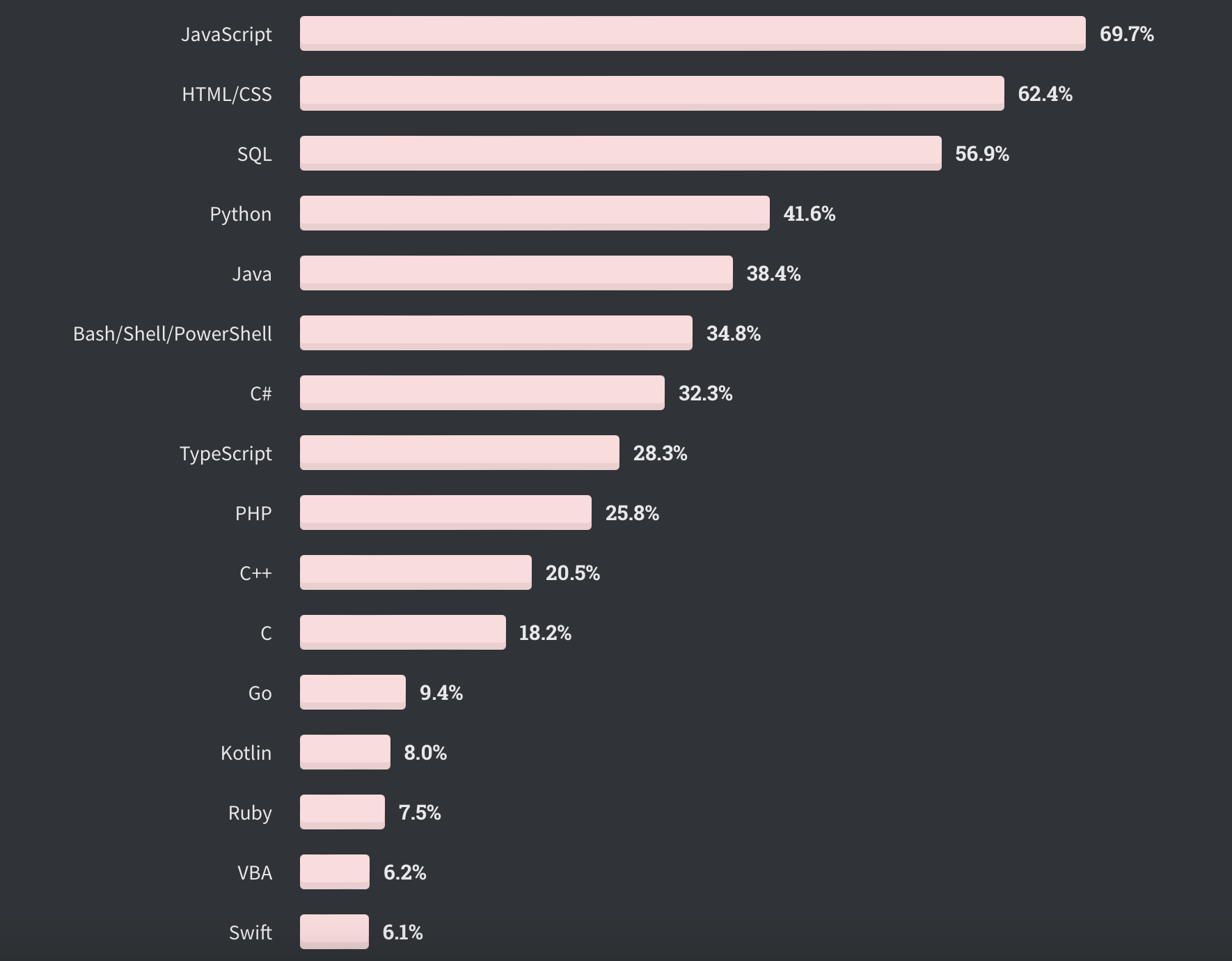The backend significantly impacts the end user’s experience with your application or website. Use a subpar tool, and you risk having a slow, unreliable product prone to crashes. You want a scalable, robust, secure tool to ensure smooth performance and a positive user experience. That’s where the Golang vs NodeJS debate comes in.
Both of these tools are popular amongst developers. So the question is, which one is best for your backend project?
The answer is it depends. Several factors, like your project requirements, team expertise, and personal preferences, need consideration.
To make your job easier, we’ll compare Golang vs NodeJS to help you decide which one is the best programming language for your backend needs. But first, let’s go back to the basics.
What is Go?
Golang (or just Go) is a multipurpose programming language developed by Google in 2007 and available under the GPL. It combines the speed and security of C/C++ with Python’s flexibility.
As a result of its outstanding garbage collection management, memory safety, and enticing user interfaces, Go is a popular language for managing concurrent programming.
Although Go isn’t recommended for websites, it’s ideal for cloud-based interfaces, networking apps, real-time application platforms, and microservices.
Pros and Cons of Golang
Pros
- As a programming language, Go stands out for its clarity because it enforces a clear and simple syntax.
- Because it’s so close to C++, programmers don’t have to slog through voluminous instructions to get up to speed.
- Rather than being a hybrid language, Go utilizes a statically typed language that compiles directly to machine code. As a result, Go is highly efficient in terms of performance and execution speed.
- Go’s compiled binary has a similarly small size. On the other hand, this multipurpose programming language has built-in support for garbage collection, a high-level language feature.
- Thanks to the language’s use of Go, Concurrency in applications can be handled better with Go’s available tools.
- GoRoutines gives programmers the ability to create concurrent multithreaded functions.
- Spreading the CPU burden and preventing the program from crashing are obvious benefits.
- Golang’s code is substantially cleaner since it’s written in a statically typed language.
- The compilation will reveal any flaws in the source code. Additionally, the garbage collector guards against memory leaks by automatically releasing memory from redundant objects when developers fail to do so.
Cons
- Go has a thriving community with libraries and tools to support it. However, it’s still small compared to other languages like Java or Python. This means that the community support in terms of troubleshooting, new frameworks, or niche applications is limited and might hinder the speed or progress of your developers in the future.
What is NodeJS?
NodeJS is a server-side runtime environment based on the V8 JavaScript transformer in Google Chrome. It was initially created in 2009 by Ryan Dahl, and its latest iteration, version 15.14, was released in April 2021.
NodeJS is used to build a highly scalable server-side platform using JavaScript. This language stresses an event-driven, non-blocking I/O design. To use NodeJS, you’ll need to know JavaScript. As a result, developers now have an easier time communicating scripts on both the client and server sides using a single language.
Pros and Cons of NodeJS
Pros
- NodeJS’s efficiency is a major asset. Due to its non-blocking nature, NodeJS can process several requests at the same time. The main thread is unaffected since only the background processes are performed.
- NodeJS uses the JavaScript engine of Google V8. A code translator is not required since the engine converts JavaScript into more minor machine codes.
- Its applications benefit directly from Google’s efforts to improve the V8 JavaScript engine’s efficiency, security, and speed.
- NodeJS makes it simple to create apps that are both fast and scalable.
- Due to its inherent APIs like clusters, child processes, and worker threads, NodeJS can handle numerous requests. When the volume of requests increases, these APIs relieve the CPU of some of the work.
- Reusable code or components built using NodeJS may contribute to shorter development timelines.
- Because the NodeJS community is so large, you can utilize third-party components. NPM, the NodeJS package manager, makes over 836,000 reusable components accessible.
- When learning NodeJS, Javascript is the most popular language among developers.
- NodeJS will be simpler for JavaScript developers to learn. It implies the same group of developers working on both the front-end and the backend for businesses.
Cons
- Several open-source tools and libraries are part of the NodeJS ecosystem. However, because of this, developers become dependent on the work of third-party tool developers.
- When utilizing the tools, you may have problems with their dependability, performance, and lack of assistance. This will directly impact the NodeJS app you’re working on.
Golang vs NodeJS: Feature Comparison
Performance
Different factors influence the performance of a programming language. So, choose a programming language that makes it easy to develop programs efficiently. Consider the following factors when choosing between Golang and NodeJS:
Raw performance
When it comes to raw performance, Golang is better than NodeJS. This is because it is a fast, lightweight platform based on low-level programming languages like C or C++.
In comparison, NodeJS, a derivative of Javascript, is statically typed. As a result, it is typically slower than other programming languages. NodeJS can’t offer the performance of memory-bound tasks and CPU. In other words, NodeJS may perform well or terribly, depending on the nature of the application.
Real-life performance
In terms of real-life performance, Golang and NodeJS are relatively equal. For instance, Golang and NodeJS work equally well for database connections and network communications.
Verdict: In the Golang vs. NodeJS performance comparison, Golang comes out on top in raw performance. However, both tools perform equally in real-life performance. So, Golang wins this round.
Scalability and Concurrency
Go utilizes goroutines that enable the execution of threads and smooth concurrency. These goroutines make Golang a perfectly scalable language.
Using concurrency, Go can process over 1000 requests. This single feature gives Go the upper hand over NodeJS for scalability and concurrency. It is also important to note that NodeJS is a single-threaded asynchronous Javascript engine.
The CPU-bound tasks in NodeJS can sometimes block the event loop and cause your program to slow down. It then results in a slow app and annoys users.
Verdict: Go prevails because, through goroutines, it allows concurrency, resulting in faster processes than NodeJS single-threaded architecture.
Learning Curve
NodeJS has an easier learning curve because it uses Javascript, the most popular programming language globally. It is an asynchronous language that also contains a callback function.
Even if a developer only has a basic knowledge of Javascript, it is still easier to learn NodeJS than Golang. Numerous NodeJS resources online contain a structured learning process supported by a vast Javascript community.
Conversely, Golang full-stack developers must learn everything about a full-stack framework, like concepts, specific processes, rules, strict typing, pointers, interfaces, database connections, etc.
If you want to hire a Golang app developer for your web app project, you or someone on your team must understand Golang. In addition, Golang is solely a backend programming language. So, you will need to hire a front-end developer as well.
Verdict: NodeJS trumps Golang because it is less complicated to learn.
Error Handling
To handle errors in Golang, developers must practice explicit error checking. Consequently, a different approach is deployed to handle the run-time and compile-time errors. This leads to various issues and increases the development time.
According to Go developers, the imminent improvement in the language with the G0 2 version will include better error handling, error values, and generics.
On the other hand, NodeJS follows a traditional throw-catch model for handling errors. In this approach, developers catch errors immediately as they occur so they can debug them faster.
Verdict: NodeJS takes this round since it involves quickly catching errors during execution, aiding developers in debugging.
Development Tools
Every project manager or business owner knows that the availability of libraries and tools can significantly reduce development costs and time.
NodeJS offers an abundance of tools for various tasks. The Javascript ecosystem can help you succeed with different use cases — basic or complex.
Node Package Manager (NPM) gives you approximately 800,000 ready-made tools and libs to assist your developers in creating robust applications.
While Golang has third-party libraries to complete complex tasks, they are still evolving compared to NodeJS. Even with advanced tools like Godoc and GoMetaLiner, Golang doesn’t match up to Nodejs’ stack of tools.
Verdict: Node’js comes out ahead again. Its robust ecosystem and vast library availability make it a top choice for many developers.
Benchmarks
You can determine the best tools by running them through different tasks or algorithms and checking how long it takes each language to perform.
Below is an example that highlights the benchmark task performance of Golang and NodeJS for different computer language methods and algorithms.
Mandebrot
| Source | secs | memory | gz | CPU | CPU load |
| Golang | 5.49 | 30,915 | 906 | 21.80 | 99% 99% 99% 100% |
| NodeJS | 17.78 | 603,609 | 749 | 63.8 | 84% 99% 95% 85% |
Binary-trees
| Source | secs | memory | gz | CPU | CPU load |
| Golang | 28.3 | 434,636 | 655 | 109.59 | 94% 95% 96% 98% |
| NodeJS | 45.40 | 658,325 | 442 | 81.92 | 38% 40% 58% 47% |
N-body
| Source | secs | memory | gz | CPU | CPU load |
| Golang | 21.38 | 1,539 | 1312 | 21.39 | 0% 0% 99% 0% |
| NodeJS | 26.63 | 33,156 | 1298 | 26.63 | 100% 0% 0% 2% |
Regen-redux
| Source | secs | memory | gz | CPU | CPU load |
| Golang | 28.22 | 323,825 | 805 | 59.89 | 68% 46% 51% 49% |
| NodeJS | 4.25 | 596,425 | 435 | 4.25 | 100% 0% 0% 2% |
Pidigits
| Source | secs | memory | gz | CPU | CPU load |
| Golang | 0.13 | ? | 603 | 0.13 | 0% 8% 0% 94% |
| NodeJS | Bad Output | Bad Output | Bad Output | Bad Output | Bad Output |
Fannkuch-redux
| Source | secs | memory | gz | CPU | CPU load |
| Golang | 14.72 | 1,541 | 902 | 58.86 | 100% 100% 99% 99% |
| NodeJS | 89.64 | 30,962 | 475 | 89.62 | 0% 99% 0% 1% |
K-nucleotide
| Source | secs | memory | gz | CPU | CPU load |
| Golang | 12.78 | 148,053 | 1723 | 47.35 | 88% 98% 94% 95$ |
| NodeJS | 61.25 | 1,739,993 | 934 | 137.08 | 80% 76% 96% 71% |
Fasta
| Source | secs | memory | gz | CPU | CPU load |
| Golang | 2.07 | 3,642 | 1359 | 5.68 | 84% 67% 72% 49% |
| NodeJS | 9.6 | 34,806 | 1786 | 9.83 | 98% 1% 0% 0% |
Reverse complement
| Source | secs | memory | gz | CPU | CPU load |
| Golang | 4.1 | 824,355 | 612 | 4.16 | 1% 35% 68% 3% |
| NodeJS | 16.68 | 706,258 | 1105 | 17.73 | 71% 51% 42% 48% |
Spectrat norm
| Source | secs | memory | gz | CPU | CPU load |
| Golang | 3.96 | 2,345 | 549 | 15.73 | 100% 100% 100% 99% |
| NodeJS | 15.80 | 31,902 | 382 | 15.82 | 100% 1% 1% 0% |
Verdict: In this Golang vs. NodeJS benchmark comparison, we can see that Golang requires less time, CPU load, and memory to complete operations compared to NodeJS
Speed and Security
The Go library was created with modern development standards in mind. Besides providing scalability and concurrency, it offers developers a secure and swift environment for their app development. It can also write clean code, thanks to its incredible debugging functions.
Coding with NodeJS involves using various ready-made templates that streamline product development. It accelerates tasks to avoid any diversions and protects critical business data. Moreover, securing Golang and NodeJS code against SQL injections and sensitive information is essential.
Verdict: This is tied because both languages ensure speed and security in their unique ways.
Community
Open-source projects like Golang and NodeJS usually have communities with many developers contributing.
NodeJS has a large and vibrant community. The NodeJS foundation enables its widespread adoption. Industry leaders like GoDaddy, PayPal, IBM, and Microsoft are active members of the NodeJS foundation. Yearly, they organize Node+ JS, an event where they announce all changes and improvements.
In addition, its security and long-term support (LTS) for improved stability is overseen by a team of professionals. NodeJS now has over 80,000 stars on GitHub.
The Golang community, on the other hand, is growing yearly. But it is still smaller than NodeJS’s.
In fact, every year, Google hosts a GopherCon event to bring Go developers around the globe together to discuss new improvements.
Verdict: It is clear that NodeJS is better in this context because it has a larger community with prominent active members.
Availability of Developers
It is tricky to find Go developers because it is a relatively new language. Golang is also considered one of the most complicated frameworks. According to the 2021 Stack Overflow Developer Survey, only 9.4% of professional developers use Go. However, it has a bright future with more developers learning the language.

Since Javascript is a heavily used language — by 69.7% of professional developers — it is much easier to find developers with NodeJS expertise. As a result, you can build a team of professionals to handle multiple development projects.
Verdict: It is easier to find NodeJS-capable developers than Go, so NodeJS comes out on top here.
But if you need to hire a Go developer, DistantJob can help.
Companies Using Golang vs. NodeJS
Golang
Below is the list of companies and applications actively using Golang:
- Uber
- SoundCloud
- Twitch
- Dropbox
- DailyMotion
NodeJS
Below is a list of companies and applications actively using NodeJS:
- Walmart
- Netflix
- Trello
- PayPal
- Uber
- NASA
- eBay
- Medium
So, Which Language Should You Choose?
Golang and NodeJS are incredible tools for backend development. But after seeing how they stack against each other, which should you choose? Is Golang better than NodeJS, or is it the other way around?
According to the head-to-head comparison, NodeJS leads in five categories: developer availability, ease of learning, community, and error handling. However, Golang wins in performance, benchmark, and scalability.
Both backend programming languages have their strengths and weaknesses. Therefore, consider your project needs and your team’s expertise before choosing a tool for your backend development projects.
Looking for Golang Developers? Check out how DistantJob can help you find talented remote GO developers at a fraction of the usual cost.




